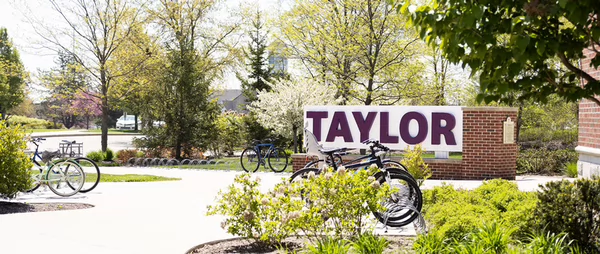Dangerous Situation (Person)
Text
TUALERT: DANGEROUS SITUATION reported on/near TU Campus. THIS IS NOT A DRILL. LOCKDOWN (away from doors & windows) deny entry to any unknown person. See email.
Email
TU Alert: DANGEROUS SITUATION reported on or near the Taylor University Campus. THIS IS NOT A DRILL.
LOCKDOWN (away from doors and windows) deny entry to any unknown person.
Please do NOT call the Taylor Police for information, as our staff will be focused on responding to the incident. Call only if you have information about the dangerous situation.
Voice
This is a TU Alert. There has been a DANGEROUS SITUATION reported on or near the Taylor University campus. THIS IS NOT A DRILL. LOCKDOWN (away from doors and windows) and deny entry to any unknown person. See email for additional details.
Computer Pop-up
TUALERT: DANGEROUS SITUATION reported on/near TU Campus. THIS IS NOT A DRILL. LOCKDOWN (away from doors & windows) deny entry to any unknown person. See email.
Shelter in place (environmental emergency)
Text
HAZARDOUS CONDITION on/near TU campus. SHELTER-IN-PLACE immediately away from doors & windows. Check TU email for more details.
Email
TUALERT: HAZARDOUS CONDITION!
There is a HAZARDOUS CONDITION on or near Taylor University. SHELTER-IN-PLACE immediately, away from doors and windows.
Please do NOT call the Taylor Police for information, as our staff will be focused on responding to the incident. Call only if you have information about the hazardous condition.
We will send update messages as new information is available
Please remain in a secure place until you receive an ALL CLEAR message.
Voice
This is a TU Alert. There is a HAZARDOUS CONDITION on or near the campus of Taylor University. Seek shelter immediately, away from doors and windows.
Please do NOT call the Taylor Police for information, as our staff will be focused on responding to the incident. Call only if you have information about the hazardous condition.
We will send update messages as new information is available, and updates will be posted on the college website.
Please remain in a secure place until you receive an ALL CLEAR message.
Thank you.
Computer Pop-up
HAZARDOUS CONDITION on/near TU campus. SHELTER-IN-PLACE immediately away from doors & windows. Check TU email for more details.
Tornado Warning
Text
TUALERT: TORNADO WARNING issued for Grant County, including Taylor University – Seek Shelter immediately. See TU email for more details.
Email
TUALERT: The National Weather Service has issued a Tornado Warning for Grant County, which includes Taylor University. If you are on campus or in the county, you are advised to seek shelter immediately.
Please do NOT call the Taylor Police for information, as our staff will be focused on responding to the incident. Call only if there is an urgent situation or call 911 for an emergency.
Here are important tips from the state of Indiana about what to do during a Tornado:
Move to the lowest level of a sturdy building. It is best to go to a basement, safe room or storm cellar. If unavailable, use an interior room or hallway where there are no windows. Cover your head and neck with your arms. Blankets, pillows
and furniture can provide additional protection.
If in a vehicle, the best choice is to get out and take shelter in a strong building. If no building is available, stay in the vehicle, keep your seatbelt on, lower your head below the window and cover your head and neck with your arms and a blanket.
Do not take shelter at bridges. Strong winds can cause damage to the structure and cause it to collapse, you are not protected from flying debris and vehicles stopped there can block roadways and prevent others from reaching real shelter.
Stay tuned to TUAlert or a local weather station for further updates on the storm. Please do not call Taylor Police unless you have a very urgent situation, as they will be dealing with many calls from this storm. If you have an emergency, please dial 911.
Voice
This is a TUAlert. The National Weather Service has issued a tornado warning for Grant County, which includes Taylor University. If you are on campus or in the county, you are advised to seek shelter immediately. Additional information has been sent to your Taylor University email address.
Computer Pop-up
TUALERT: TORNADO WARNING issued for Grant County, including Taylor University – Seek Shelter immediately. See TU email for more details.
Run, Hide, Fight
Text
TUAlert: ACTIVE THREAT reported at Taylor University. THIS IS NOT A DRILL. If in the danger area and safe to do so, RUN, Otherwise, LOCKDOWN (deny entry; prepare to FIGHT)
Email
TUALERT: ATTENTION Taylor Community:
THIS IS NOT A DRILL. We have received a credible report of an active threat at Taylor University.
If — based on what you SEE and HEAR — you believe you are in the danger area (the general vicinity of the threat), and you have determined that you can do so safely, you should RUN and ESCAPE to a safe location immediately.
If you can't safely run, or if you are not in the vicinity of the threat, LOCKDOWN IMMEDIATELY (barricade the door, if possible) and deny entry until more information is available (either from us or your own observations). Remember your lockdown training and be prepared to FIGHT, if you decide you must do so. (RUN-HIDE-FIGHT.)
At this time, no additional information is known.
Voice
This is a TU Alert. ACTIVE THREAT reported at Taylor University. THIS IS NOT A DRILL. Remember RUN-HIDE-FIGHT training. If you are in the danger area, RUN (if you determine it is safe to do so). Otherwise, LOCKDOWN (deny entry; prepare to FIGHT, if necessary). See Taylor email (if safe to do so) for additional details.
Computer
Pop-up TUAlert: ACTIVE THREAT reported at Taylor University. THIS IS NOT A DRILL. If in the danger area and safe to do so, RUN, Otherwise, LOCKDOWN (deny entry; prepare to FIGHT)

